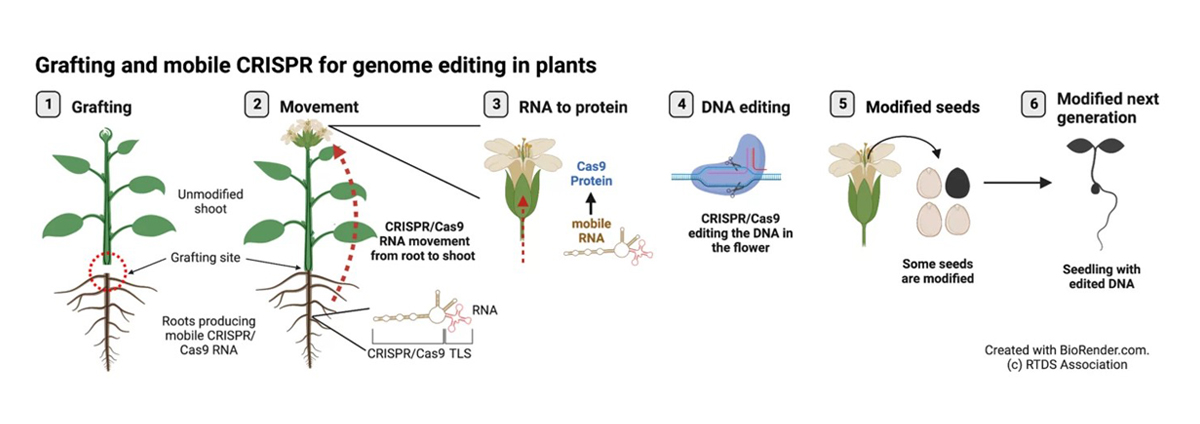
Grafting and Mobile CRISPR Overcomes Limitations of Genome Editing in Plants
January 11, 2023| |
Scientists from the Max Planck Institute of Molecular Plant Physiology use a ground-breaking twist to the CRISPR tool to edit plant genomes. The discovery, signaling a methodology change, could simplify and speed up the development of novel, genetically stable commercial crop varieties by combining grafting with a ‘mobile' CRISPR tool.
An unmodified shoot is grafted onto roots that contain a mobile CRISPR-Cas9, allowing the genetic scissor to move from the root into the shoot. It then edits the plant DNA but leaves no trace of itself in the next generation of plants. This breakthrough will save time and money and circumvent current limitations in plant breeding and contribute to sustainable food solutions across multiple crops.
The group studies transport sequences that enable RNA movement from roots to shoots. They identified tRNA-like sequences (TLS) that act as signals for the long-distance movement of RNAs within plants. The recent breakthrough came by combining this discovery with the CRISPR-Cas9 genome editing system. When a TLS is added to the CRISPR-Cas9 sequences, plants produce “mobile” versions of CRISPR-Cas9 RNA. A transgene-free, unmodified shoot is then grafted onto the plants' roots containing mobile CRISPR-Cas9 RNA, which then moves from the root into the shoot and eventually into the flowers that produce the seeds.
The new system makes it possible to combine different species. The scientists showed that ‘editing' in this way also works when root and shoot are from other plant species. The group grafted shoots of oilseed rape onto Arabidopsis roots that produce the mobile CRISPR-Cas9 and found edited oilseed rape plants. “Our novel gene editing system can be used efficiently for many breeding programs and crop plants. This includes many important agricultural plant species that are difficult or impossible to modify with existing methods,” research group leader Friedrich Kragler concluded.
For more details, read the article on the Max-Planck-Gesellschaft Newsroom.
| |
You might also like:
- Pocket K No. 54: Plant Breeding Innovation: CRISPR-Cas9
- The Current Status of CRISPR-Cas9 Applications in Food and Agri
- New Plant Breeding Techniques: CRISPR/Cas9 System
Biotech Updates is a weekly newsletter of ISAAA, a not-for-profit organization. It is distributed for free to over 22,000 subscribers worldwide to inform them about the key developments in biosciences, especially in biotechnology. Your support will help us in our mission to feed the world with knowledge. You can help by donating as little as $10.
-
See more articles:
-
Gene Editing Supplement (January 11, 2023)
-
Research and Tools
- Epigenome Editing Enhances Resistance Against CBB
- Seed Shattering 11 Controls Seed Shattering in African Rice
- Grafting and Mobile CRISPR Overcomes Limitations of Genome Editing in Plants
- Researchers Resurrect CRISPR's 2.6 Billion-Year-Old Ancestors
- Multiplex Base-Editing System Reveals Unidentified Fungal Strains with Medical Potentials
-
Public Acceptance and Engagement
- Survey Shows US Consumers Value Taste Over Breeding Method of Table Grapes
-
Read the latest: - Biotech Updates (December 17, 2025)
- Gene Editing Supplement (December 17, 2025)
- Gene Drive Supplement (February 22, 2023)
-
Subscribe to BU: - Share
- Tweet

